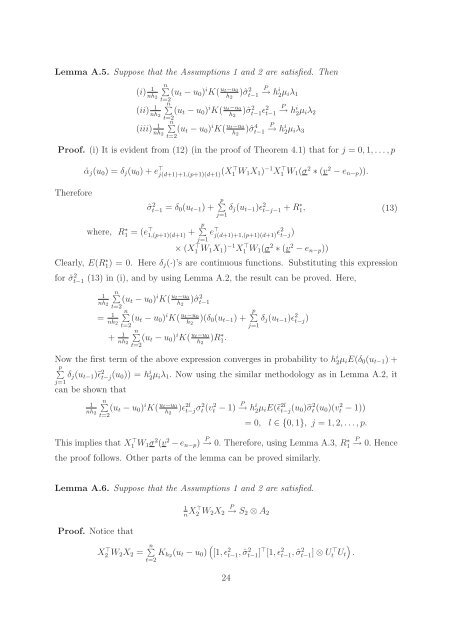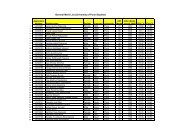Non-parametric estimation of a time varying GARCH model
Non-parametric estimation of a time varying GARCH model
Non-parametric estimation of a time varying GARCH model
Create successful ePaper yourself
Turn your PDF publications into a flip-book with our unique Google optimized e-Paper software.
Lemma A.5. Suppose that the Assumptions 1 and 2 are satisfied. Then<br />
(i) 1<br />
n�<br />
(ut − u0) nh2<br />
t=2<br />
iK( ut−u0)ˆσ<br />
h2<br />
2 P<br />
t−1 → hi 2µiλ1<br />
(ii) 1<br />
n�<br />
(ut − u0) nh2<br />
t=2<br />
iK( ut−u0)ˆσ<br />
h2<br />
2 t−1ǫ2 P<br />
t−1 → hi 2µiλ2<br />
(iii) 1<br />
n�<br />
(ut − u0) nh2<br />
t=2<br />
iK( ut−u0)ˆσ<br />
h2<br />
4 P<br />
t−1 → hi 2µiλ3<br />
Pro<strong>of</strong>. (i) It is evident from (12) (in the pro<strong>of</strong> <strong>of</strong> Theorem 4.1) that for j = 0, 1,...,p<br />
Therefore<br />
ˆαj(u0) = δj(u0) + e ⊤ j(d+1)+1,(p+1)(d+1) (X⊤ 1 W1X1) −1 X ⊤ 1 W1(σ 2 ∗ (v 2 − en−p)).<br />
ˆσ 2 t−1 = δ0(ut−1) + p �<br />
δj(ut−1)ǫ2 t−j−1 + R∗ 1, (13)<br />
where, R ∗ 1 = (e ⊤ 1,(p+1)(d+1) + p �<br />
j=1<br />
e<br />
j=1<br />
⊤ j(d+1)+1,(p+1)(d+1) ǫ2t−j) × (X⊤ 1 W1X1) −1X ⊤ 1 W1(σ2 ∗ (v2 − en−p))<br />
Clearly, E(R ∗ 1) = 0. Here δj(·)’s are continuous functions. Substituting this expression<br />
for ˆσ 2 t−1 (13) in (i), and by using Lemma A.2, the result can be proved. Here,<br />
n� 1 (ut − u0) nh2<br />
t=2<br />
iK( ut−u0)ˆσ<br />
h2<br />
2 t−1<br />
= 1<br />
n�<br />
(ut − u0) nh2<br />
t=2<br />
iK( ut−u0)(δ0(ut−1)<br />
+ h2<br />
p �<br />
δj(ut−1)ǫ<br />
j=1<br />
2 t−j)<br />
+ 1<br />
n�<br />
(ut − u0) nh2<br />
t=2<br />
iK( ut−u0)R<br />
h2<br />
∗ 1.<br />
Now the first term <strong>of</strong> the above expression converges in probability to hi 2µiE(δ0(ut−1) +<br />
p�<br />
δj(ut−1)�ǫ 2 t−j(u0)) = hi 2µiλ1. Now using the similar methodology as in Lemma A.2, it<br />
j=1<br />
can be shown that<br />
n�<br />
(ut − u0) iK( ut−u0)ǫ2l<br />
t−jσ2 t (v2 t − 1) P → hi 2µiE(�ǫ 2l<br />
t−j(u0)�σ 2 t (u0)(v2 t − 1))<br />
1<br />
nh2<br />
t=2<br />
h2<br />
= 0, l ∈ {0, 1}, j = 1, 2,...,p.<br />
This implies that X ⊤ 1 W1σ 2 (v 2 − en−p) P → 0. Therefore, using Lemma A.3, R ∗ 1<br />
the pro<strong>of</strong> follows. Other parts <strong>of</strong> the lemma can be proved similarly.<br />
Lemma A.6. Suppose that the Assumptions 1 and 2 are satisfied.<br />
Pro<strong>of</strong>. Notice that<br />
X ⊤ 2 W2X2 = n�<br />
t=2<br />
1<br />
n X⊤ 2 W2X2<br />
P<br />
→ S2 ⊗ A2<br />
Kh2(ut − u0) �<br />
[1,ǫ2 t−1, ˆσ 2 t−1] ⊤ [1,ǫ2 t−1, ˆσ 2 t−1] ⊗ U ⊤ �<br />
t Ut .<br />
24<br />
P<br />
→ 0. Hence



